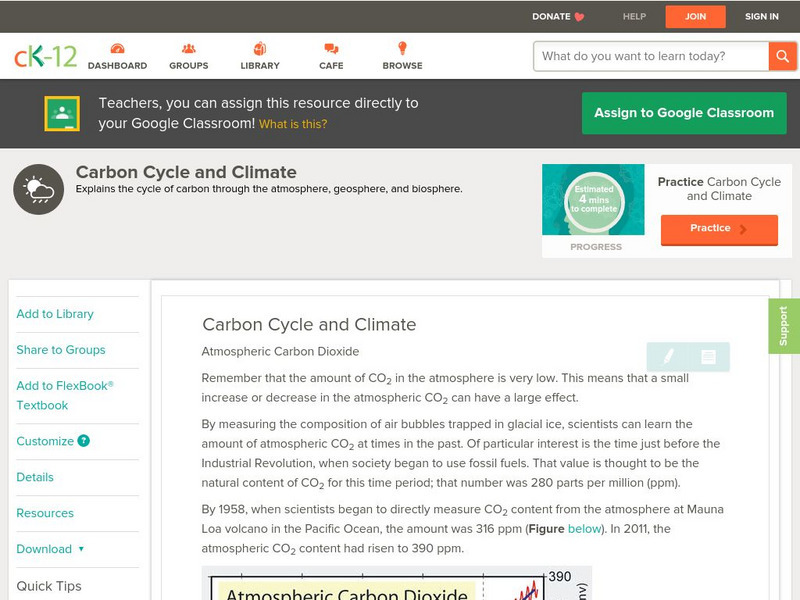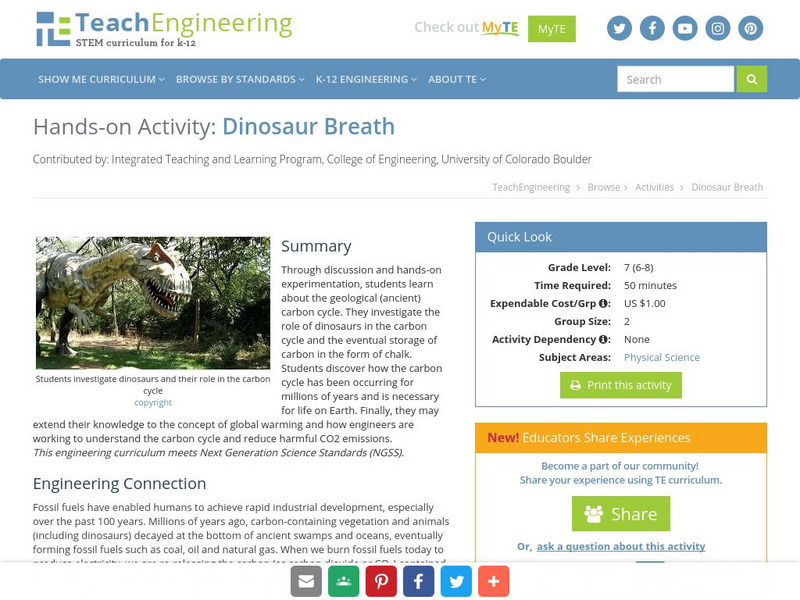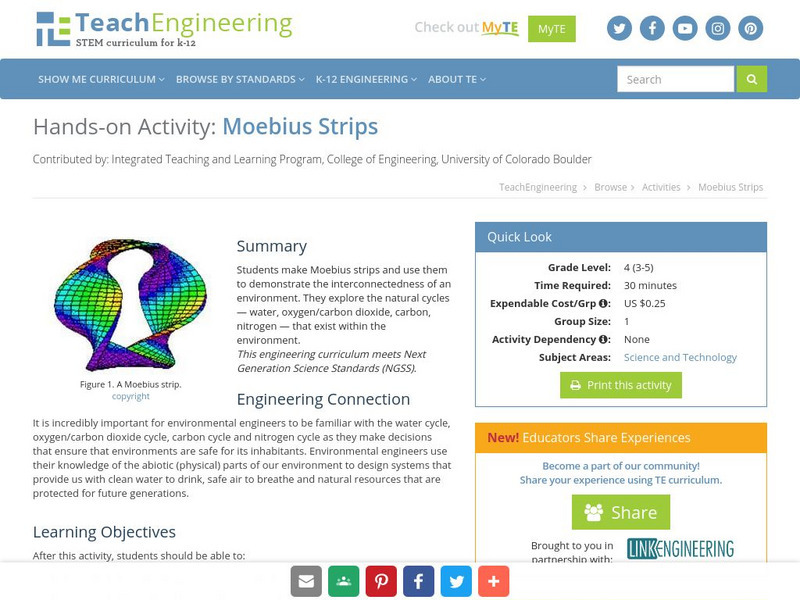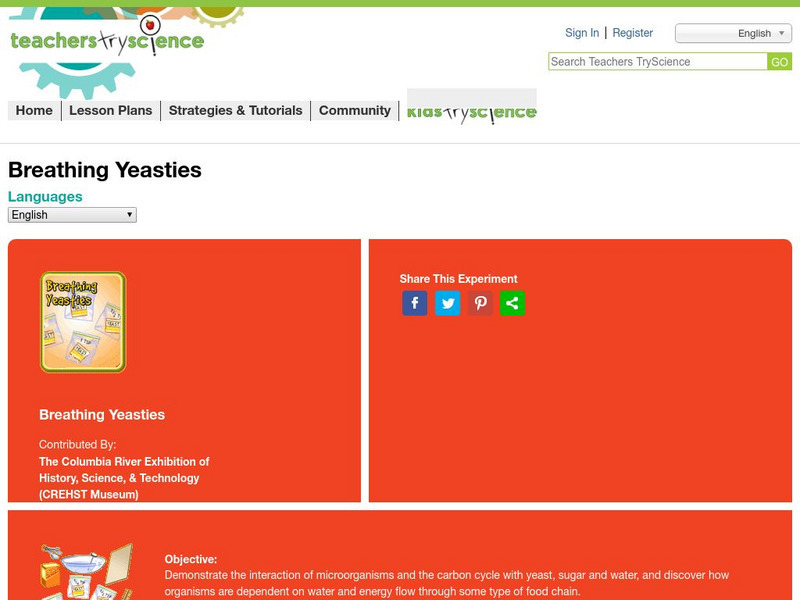BiologyWise
Biology Wise: An Easy Explanation of the Carbon Cycle for Kids
The importance of the carbon cycle, how it works, the sources of carbon, and the steps in the carbon cycle are explained here.
BiologyWise
Biology Wise: A Brief Guide to the Steps of the Carbon Cycle
Outlines the steps for the movement of carbon along the carbon cycle through photosynthesis, food chains, being dissolved into the ocean, the decomposition of organisms, fossil fuel formation, industrial use of fossil fuels, carbon...
CK-12 Foundation
Ck 12: Earth Science: Carbon Cycle and Climate
[Free Registration/Login may be required to access all resource tools.] How carbon circulates throughout the environment.
CK-12 Foundation
Ck 12: Earth Science: Carbon Cycle and Climate
[Free Registration/Login may be required to access all resource tools.] How carbon circulates throughout the environment.
Ducksters
Ducksters: Science for Kids: Carbon Cycle
Kids learn about the carbon cycle and how this nutrient travels through the ecosystem to sustain life on Earth.
TeachEngineering
Teach Engineering: Dinosaur Breath
Through discussion and hands-on experimentation, students learn about the geological (ancient) carbon cycle. They investigate the role of dinosaurs in the carbon cycle and the eventual storage of carbon in the form of chalk. Students...
National Geographic
National Geographic: Sources, Sinks, and Feedbacks
Students will learn about how the Earth's carbon cycle works, as they examine the relationship between levels of carbon dioxide and water vapor in the atmosphere and the temperature of the ocean's surface. Includes online student...
Annenberg Foundation
Annenberg Learner: Carbon Lab
This lab uses a robust model of the carbon cycle to give an intuitive sense for how carbon circulates through the atmosphere, biosphere, oceans, and crust.
TeachEngineering
Teach Engineering: Biorecycling: Using Nature to Make Resources From Waste
By studying key processes in the carbon cycle, such as photosynthesis, composting, and anaerobic digestion, students learn how nature and engineers biorecycle carbon.
Morning Earth
How Life Works: Biosphere Is Process: Animal & Plant Gas Exchange
Scholars explore the biology concept of the oxygen cycle. The tutorial consists of definitions and pictures about animal and plant gas exchange.
TeachEngineering
Teach Engineering: Moebius Strips
In this activity, students make Moebius strips and use them to demonstrate the interconnectedness of an environment. They will explore the natural cycles (water, oxygen/carbon dioxide, carbon, nitrogen) within the environment.
Other
Marietta College: Ecosystems
Complete illustrated discussion of energy flow within ecosystems, including discussions of trophic levels, ecological pyramids, food chains and webs, biological magnification, and cycles.
Teachers TryScience
Teachers Try Science: Breathing Yeasties
See how combining yeast, sugar, and water can demonstrate the carbon cycle and show how microorganisms work in the food chain.
NASA
Nasa Earth Observatory: Mystery of the Missing Carbon
This article discusses the mystery of the one to two billion metric tons of missing carbon from the global carbon budget. Scientists do not know where between fifteen and thirty percent of the carbon released each year disappears to, but...
Wikimedia
Wikipedia: Aerobic Respiration
Wikipedia provides an indepth yet brief description of the oxygen dependent respiration with links to Kreb's cycle and Oxidative phosphorylation.
PBS
Pbs: Nova: Illuminating Photosynthesis
To understand the process of photosynthesis, follow the hydrogen, carbon, and oxygen atoms as they travel between the air, the plant, and the soil.
TeachEngineering
Teach Engineering: Lasers, Let's Find 'Em!
Students research particular types of lasers and find examples of how they are used in technology today. Teams present their findings by means of PowerPoint presentations, videos or brochures. The class takes notes on the presentations...
NASA
Nasa: Cosmic Chemistry: An Elemental Question
Explore the periodic table like never before! This downloadable program module for students comes absolutely complete with teacher modules, student assessments, PowerPoints, Excel spreadsheets, historical text readings and more. Students...
Center for Innovation in Engineering and Science Education, Stevens Institute of Technology
Ciese: Carbon Imbalance: Algae to the Rescue? [Pdf]
A 95-page learning module that integrates biology, chemistry, and engineering. It includes in-class labs, virtual labs, and engineering design activities. Working with algae, students learn about and investigate how photosynthesis,...
Other
The Amazing World of Science With Mr. Green: Introduction to the Atmosphere
This teacher website provides a comprehensive lesson unit on the structure of Earth's atmosphere and how it sustains and impacts life on Earth and its ecosystems. Includes labeled diagrams, student worksheets, a slideshow, flashcards,...
Nature Research
Nature Education: Energy Economics in Ecosystems
This article discusses how plants and microorganisms, until recently, have mostly controlled how much carbon dioxide is released into an ecosystem, and explains how this process works. Humans' burning of fossil fuels has upset the...
Other
Water on the Web
Water on the Web (WOW) is an advanced site allowing students to actively participate in data analysis from real research sites. Lesson plans on a range of topics are provided. There is also a tutorial for using Excel to graph WOW data.
Read Works
Read Works: A Drop's Journey
[Free Registration/Login Required] An informational text about water and the water cycle. A question sheet is available to help students build skills in reading comprehension.
CK-12 Foundation
Ck 12: Life Science: Process of Cellular Respiration
[Free Registration/Login may be required to access all resource tools.] Why do you need air to live? Of course if you didn't breathe, you couldn't survive. You need the gas oxygen to perform cellular respiration to get energy from your...

















![Ciese: Carbon Imbalance: Algae to the Rescue? [Pdf] Unit Plan Ciese: Carbon Imbalance: Algae to the Rescue? [Pdf] Unit Plan](http://content.lessonplanet.com/resources/thumbnails/455842/large/bwluav9tywdpy2symdizmdeyny0xmdcynjyylwcwy3uxni5qcgc.jpg?1674855345)



